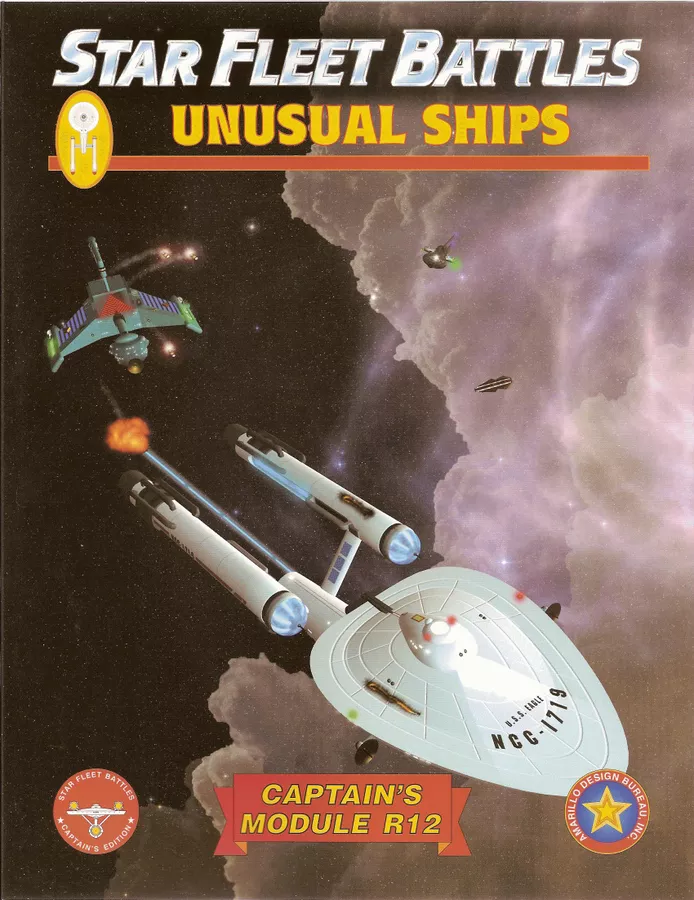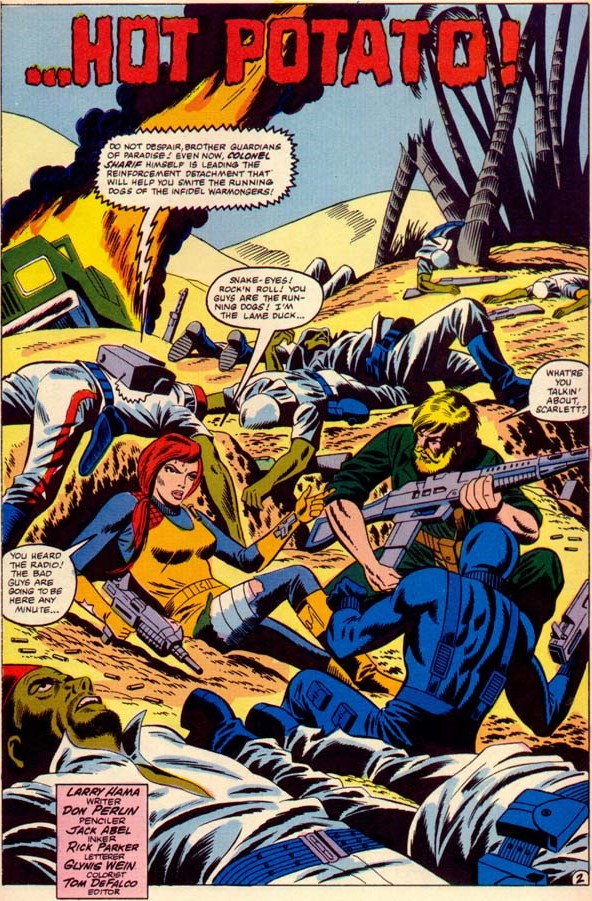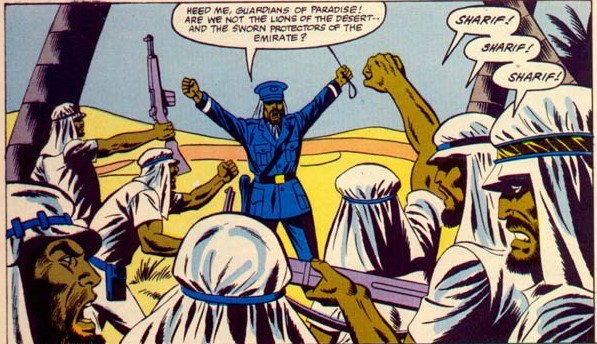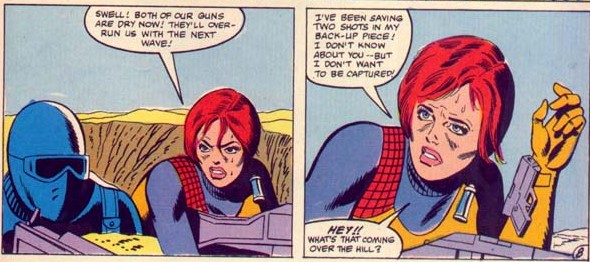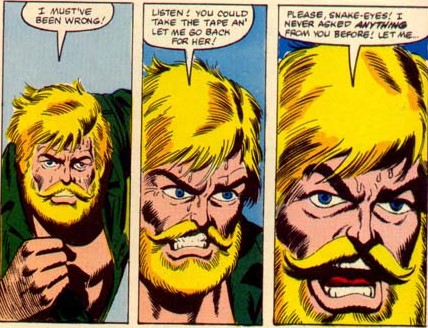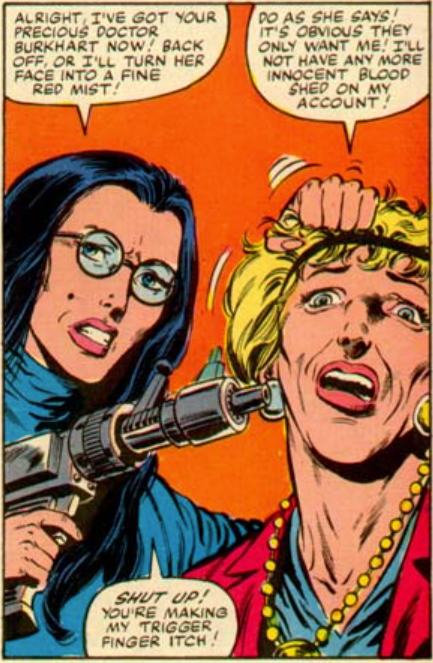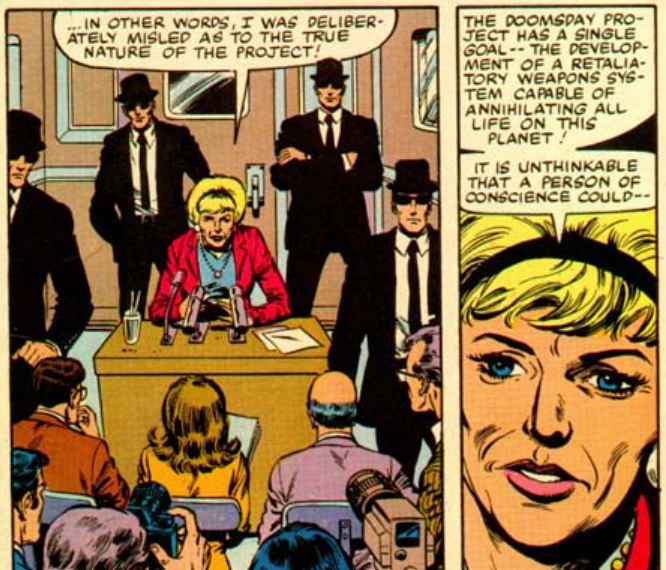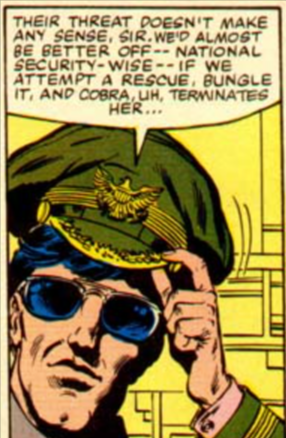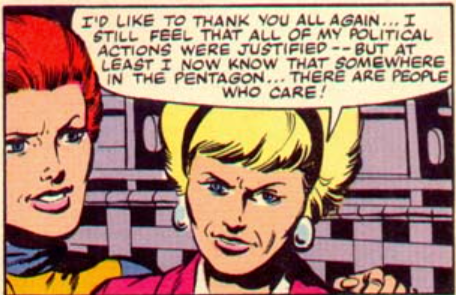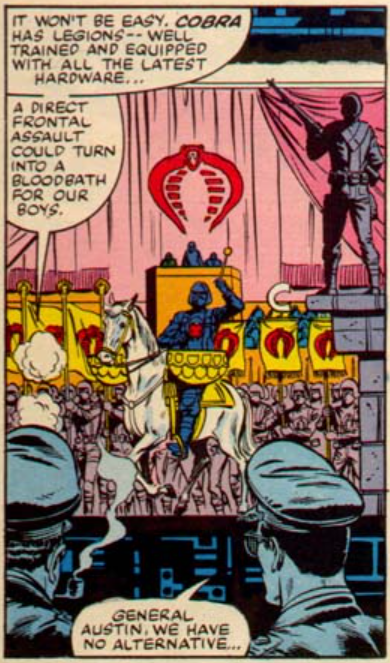So, I’m trying something a little different for a while when it comes to posting. I’ve set up a Substack newsletter and will be doing online writing over there for a while. Come join me and let’s see how it goes!
Author Archives: Andy
The Mizia Effect: Unintended Incentives in Board Games
It’s always interesting when the rules of a boardgame unintentionally incentivize gameplay that clashes with the designer’s intention. Or creates situations that aren’t technically against the letter of the rules but which feel a little contrary to their spirit.
I think this is most likely to happen when the game rules are voluminous and complex enough that it’s hard even for experienced designers or playtesters to anticipate all the ways that different game elements will interact with each other. And so it’s no surprise that my favorite examples of this phenomenon come from the spaceship combat wargame Star Fleet Battles (SFB), one of the most complex games I’ve ever played.
I’ll describe my favorite example of rules incentivizing behavior that seems unlikely to have been the intended vision: the Mizia Effect in SFB.
The Mizia Effect (named after, I believe, the player who first articulated it) is a way to make your attacks more effective by exploiting a quirk in the way the game records damage.
To explain the Mizia Effect, I need to briefly describe the way attacks and damage work in SFB.
In SFB, you control one or more starships and are usually out to blow up the other player’s ships. If you can blast your way through the enemy’s shields, your attacks start damaging vital internal ship systems. But not all internal ship systems are equally vital; damaging minor systems (like science labs or security stations) has little effect on the enemy ship’s fighting power. But damage the “right” systems (like weapons or engine power) and you can profoundly degrade their combat ability, ruining their day and making your victory much more likely.
So how do you determine which systems get hit? Well, each time damage is inflicted, you roll a die and consult a chart that lists, in order, which systems have been hit (the more damage you do, the further down the chart you go, checking off systems that have been hit).
Usually, when attacking an enemy ship, you just fire all your available weapons at once, total up the damage from all those attacks, roll on that damage chart, and go down the chart checking off damaged systems. It’s convenient to combine your attacks like this, and it also feels very cinematic. Imagine Captain Kirk shouting “Give them everything we’ve got!” and the Enterprise unloading its arsenal of phasers and torpedoes at a Klingon Bird of Prey and you get the picture.
What clever players noticed, however, is that this chart ever so slightly frontloads important systems (like weapons and engine power) toward the top of the list.
Can you see where this is going?
What players realized is that if you split that mega-attack into a bunch of smaller, separate attacks, each of those smaller attacks would trigger a fresh roll on that all-important damage table. And since critical systems are slightly overrepresented at the top of that table, a series of small attacks will damage more of those important systems than one big satisfying attack will.
Here’s an example: if you have five phasers that all fire at once, they combine their damage and might hit a total of 10 internal systems, determined by one roll on the damage table.
But if you fire those five phasers separately, each of those tiny separate attacks only damages 2 internal systems but each triggers a fresh roll on the table. Which has the most important systems listed at the top.
Now, there’s a little more complexity to this; it takes skill and knowledge of the rules to set up a situation where you can do lots of consecutive little attacks like this. But I won’t bore you with the exhaustive details. Suffice it to say that in every SFB game I ever played, players went out of their way to stagger small individual attacks across multiple impulses (what might be called “turns” in another game), rather than firing everything at once. Any SFB veteran will tell you that understanding and exploiting the Mizia Effect is a fundamental requirement of playing effectively.
Is it a cheesy tactic that ruins the game? No; everyone can exploit this equally, so it’s not unfair. Are you a bad person for noticing that the damage table can be exploited like this? Again, no.
But does it create somewhat bizarre situations where giant starships, locked in a duel to the death, goofily exchange lots of little pinprick attacks instead of unleashing glorious alpha strikes?
Yes. Yes it does.
(I don’t keep up with the SFB community much, but the last time I checked, the designers did not consider this a flaw in the game system. And as far as I know, the damage system and table remains unchanged. To be honest, this makes me glad: quirks like this add flavor to a game system that is otherwise very complex and more than a little humorless.)
Queen of Cities: Exploring Constantinople in Roleplaying Games
I love the city of Constantinople. In bygone days, I studied Byzantine history in graduate school, and have always found the city (and its modern incarnation as Istanbul) fascinating.
I also play a lot of roleplaying games. Which means that I’ve always got my eye out for roleplaying books that reference—or better yet, detail—the city of Constantinople as the setting for a roleplaying campaign.
So are there roleplaying books about Constantinople out there? Surely, if you can buy a 700-page tome about the fantasy city of Ptolus, then somebody must have published a book that lavishes similar detail on the important real-world-historical Queen of Cities… right?
Let’s find out.

First, a Word About Historical Sourcebooks for Roleplaying Games
Historical sourcebooks for RPGs—that is, books that describe a real-world location for use in a roleplaying campaign—have always been a somewhat odd type of product.
In the roleplaying hobby, there’s a widely-held assumption that gamers overwhelmingly prefer fantastical settings over strictly historical ones. As a result, games set in historical time periods and places almost invariably add a layer of fantasy, magic, alt-history, or the supernatural on top of the history. Sometimes the fantastic elements are so strong that the setting only marginally relates to real history (as in Deadlands).
There are a lot of reasons for this and it’s an interesting topic. But one obvious point is that real historical information about most places and times is readily available to anyone with access to Wikipedia. This was less true decades ago before the internet; but even back then, you didn’t want to spend your hard-earned money on a gamebook mostly filled with information you could find in any history book on the topic. You also don’t want a gamebook that feels like a boring history textbook (well, I want that, but I assume most other people don’t). You want something extra, and most games supply this in the form of supernatural horror or fantasy integrated into the real-world stuff.
What’s the right balance between providing comprehensive historical information, and giving players tools to bend the setting in the non-historical direction of their choice? Many game writers have tried to find that balance.
These challenges have led to a situation where there just aren’t very many purely straight-history roleplaying games or sourcebooks out there. The heyday of this type of gamebook is probably the 1980s and 1990s—not coincidentally, the age of GURPS 3rd edition. But we’ll get to that later.
Are There Game Books about Constantinople?
It turns out that there are!
The earliest game books in my library that reference Constantinople are these:
- The Crusades Campaign Sourcebook (1994) for AD&D 2nd edition references Constantinople, although not in any detail. This book is remarkable for being one of a small handful of historical sourcebooks published officially for Dungeons and Dragons–something that was tried briefly in the 1990s and never again since. I mostly include it here because it describes a campaign setting that is at least adjacent to Constantinople. (It only covers the first three crusades in detail—it comically and accurately sums up the later crusades, one of which very directly involves Constantinople, as “elaborate fiascos noted almost entirely for their religious intolerance, visceral greed, and senseless destruction.”
- I was hoping that we’d get some hints of early Constantinople as a game setting in GURPS Imperial Rome, but it’s only briefly referenced in a short biography of Constantine. Fair enough, given the book’s title and focus.
Those are books with minor references to Constantinople. What about books specifically dedicated to the city? Believe it or not, we have quite a few!
Constantinople by Night (White Wolf, 1997)

Constantinople would be a fantastic haunt and hunting ground for vampires, and clearly somebody else agreed with me, because in the late 90s this book was released for the Vampire: The Dark Ages game line.
White Wolf published a large number of [City] by Night sourcebooks through the 90s. This series of game books was not renowned for its historical, geographic, or linguistic accuracy—I think the charitable way of putting it would be that White Wolf prioritized mood, theme, and aesthetic over historical accuracy or grammatically-correct Latin. And this book is all about theme!
This 130-page sourcebook describes Constantinople in 1197 CE as a vampire would have experienced it, right before the Fourth Crusade engulfs the city in destruction. The mood is melancholy and apocalyptic, as if everyone (or at least, all the vampires) can sense that a Golden Age is about to come crashing down.
Vampire-specific lore is very heavily mixed in with real-world history and culture in this book, to the point that it’s hard to imagine getting much out of this if you aren’t playing Vampire. That said, there is a 25-page tour of major city locations; there’s plenty of vampire lore mixed in there, but I could see it being an inspirational read for any horror-themed game set in Constantinople.
This is a very fun and evocative book to read, enough so that I can almost recommend it even if you aren’t a Vampire player. But there’s little that isn’t mixed in with vampire lore and so its usefulness for other games is very limited.
The Sundered Eagle: The Theban Tribunal (Atlas Games, 2011)

The Ars Magica RPG has a reputation for historically rigorous sourcebooks, and this is no exception. As with Vampire’s take on Constantinople, this sourcebook has a lot of gameline-specific lore mixed in with its real history—in this case, it’s wizards instead of vampires who are adventuring in Byzantium. But this sourcebook has a lot more game-able information about Constantinople and Byzantium that would be useful in other games.
The Sundered Eagle is “set” in 1220, in the aftermath of the Fourth Crusade. (This is proving to be a popular time to game in Constantinople. It makes sense, but there’s like… many other exciting years that could be explored!) As a book about the Byzantine world in general, this book has a lot of really useful information about culture, politics, and religion that would be useful whether you’re playing Ars Magica or not. While some of the historical information is stuff you could glean from Wikipedia or a history book, it does a good job of calling out particularly game-relevant stuff about the setting that might not come through in a straight history: info about mobs in Constantinople, for example, or common superstitions and worldviews held by people in this era. About ten pages are devoted specifically to Constantinople.
There’s a lot in this book that is wizard-specific. But I would still recommend it for a historical campaign set in the Late Antique Mediterranean world. Yes, if you’re not playing Ars Magica, you will have to ignore or weed out a lot of this book. But I would still say that this is a great example of a book that gets the “historical accuracy vs. fantasy stuff” balance right.
GURPS Hot Spots: Constantinople, 527-1204 (Steve Jackson Games, 2012)
OK, I don’t own this one. But on the strength of other GURPS historical sourcebooks, I can’t imagine this isn’t worth investigating. It’s only 50ish pages, which feels a little slight given the time period being covered. But I appreciate the expansion of the timeline beyond the Fourth Crusade.
If you’re interested, go buy this, read it, and let me know how it is!
Horror on the Orient Express (Chaosium, originally published in 1991; this is the 2014 Kickstarted revision)

This is a mega-campaign for the Call of Cthulhu RPG. It takes place across the entirety of the Orient Express railroad path, but it does have several individual scenarios set in Constantinople past and present. The historical scenarios are presented as flashbacks that the players can experience.
- “Sanguis Omnia Vincet” takes place in 330; the players are elite soldiers serving under Constantine.
- “The Dark Crusader” is set in Constantinople in the familiar Fourth Crusade time period (it actually takes place during the sack of the city in 1204!).
- “By the Skin of the Teeth” is set in 1923 Constantinople.
- “The Simulacrum Unbound” takes place in modern-day Istanbul.
There’s something fascinating about the idea of dipping into Constantinople at different points in history—a committed gamemaster could do a lot with how the city does and doesn’t change over the centuries.
These are all compelling scenarios, but they aren’t easily disentangled from the specific Call of Cthulhu campaign they’re part of. Each scenario contains some setting information about Constantinople/Istanbul, but it’s mostly restricted to information that will come up in the specific scenario.
Which means Horror on the Orient Express isn’t a good general sourcebook on the City. But hey, if you’re running this campaign, you could expand these scenarios with information from some of the other books in this list!
Mythic Constantinople (The Design Mechanism, 2017)

This is the gold standard of roleplaying books about Constantinople. Although the word “mythic” is in the title, there’s more than enough here to run a strictly historical campaign. There’s lots about both the City and the Byzantine world in general. The default setting is 1450, later than the other books in this list. It’s got lots of info about religion, politics, war, factions, and just everyday life. It puts a special emphasis on creating believable characters in the setting.
While it’s written specifically for the Mythras RPG, that game system—based on the d100 Basic Roleplaying engine—is one of the most “generic” systems in the hobby, and thus easily converted to the system of your choice.
I really can’t praise this one enough.
Honorable mention: Constantinople in other game books
Constantinople pops up as a presence in a few other books.
- The Last Days of Constantinople: Roleplaiyng in the Byzantine Empire (Avalanche Press, 2003) is an adventure that came out in the heady days of the “d20 bubble” and lets players of D&D 3rd edition experience the fall of Constantinople to the Turks in 1453. I haven’t read this one! It looks more like a single adventure than a sourcebook on Constantinople, but my curiosity is piqued.
- The Dracula Dossier campaign for Pelgrane Press’s Night’s Black Agents is a world-spanning campaign that might involve visiting modern-day Istanbul, so there’s a bit of Istanbul information in that book. There’s also a scenario in The Edom Files that is set partly in late-19th-century Constantinople. Neither provides anything like an exhaustive depiction of the City, though.
- It’s my understanding that Achtung Cthulhu’s “Zero Point” campaign takes players to World War 2-era Istanbul—but since I don’t own this, I can’t confirm it.
- There are plenty of fantasy settings that include cities or regions inspired by, or based on, Constantinople and Byzantium. The Al-Qadim, Golarion, and Glorantha settings all have regions that I suspect are meant to evoke this. But that’s speculative, and something to be unpacked in a future post.
In summary
I hope you’ve enjoyed this tour of Constantinople as found in roleplaying games! This isn’t an exhaustive list; it’s just items that have found their way into my collection and/or awareness. I am 100% certain that I’ve missed some good Constantinople source material. Let me know in the comments below what I’ve missed!
Marvel’s GI Joe Retrospective, Issue #3: “The Trojan Gambit”
This post is part of a series revisiting Marvel’s 1980s GI Joe comic books. Here’s an introduction to this series.
What’s the story?
Determined to locate the Joes’ hidden headquarters, Cobra allows one of their combat robots to fall into the hands of GI Joe. Once the robot is moved to the Pitt—the Joes’ headquarters, hidden beneath the real-life Fort Wadsworth in Staten Island—the robot activates. Its programming directs it not just to battle the Joes, but to make its way to the outside world, where it can broadcast to Cobra the location of the Pitt. Through a combination of ingenuity and luck, the Joes stop the robot before it can expose the location of their secret base.
What’s noteworthy about this issue?
The Pitt. Like any team of superheroes, the Joes need a headquarters—preferably, a secret one. As we learn in this issue, this is the Pitt, a subterranean base concealed beneath the utterly innocuous-sounding Chaplain’s Assistant School in Ford Wadsworth, New York. The Pitt’s location and features will be important in future issues, so we get a pretty thorough explanation of its layout and organization. It descends six levels below the surface—deep enough that its lowest levels would escape the effects of a “small nuke”—and contains different levels for vehicle storage, personnel quarters, and more. Importantly, Cobra does not (yet) know its location.
Hacking before the internet. The evil robot’s first action, once it reactivates, is to “hack” the Joe computer network to imprison the Joes in their own base. The robot must access the Pitt’s computer system to do this—but don’t forget, this is September 1982, well before the internet (as we know it today) existed. This means that when the robot “hacks” the Joe’s computer network, it must physically interact with their computers by detaching its hand to type on a physical keyboard. Be patient; in just two years, William Gibson’s Neuromancer will be published, and our idea of what “hacking” looks like will begin to evolve. But for now, the robot must type its sinister commands into an actual, specific computer console.
Indistinguishable Joes. This issue highlights a design problem with the original lineup of GI Joes: they all look alike. This issue features (among others) classic Joes like Zap, Clutch, Steeler, Breaker, Hawk, and Flash… all of whom wear a variant of the exact same green uniform. Yes, there are obvious efforts to give them visually distinct elements—Breaker is always blowing a bubble-gum bubble, for example—but for the most part, these characters are all visually indistinguishable from one another, especially in big action-heavy panels. (Imagine if every character in the Justice League wore a blue outfit with a red cape.) This is something that will evolve over time—already, we’ve seen that Scarlett’s uniform is visually distinct—and perhaps in recognition of this problem, most of the Joes will eventually come to sport unique (and sometimes laughably outlandish) outfits. Laugh at Shipwreck and Dr. Mindbender all you want, but you can always tell at a glance who you’re looking at.

Ingenuity over weaponry. Once the Cobra robot reactivates, it rampages through the Pitt, trying to make its way to the surface. The Joes stuck in the Pitt with it have been denied access to their regular weapons, so they must try to stop the robot with clever environmental traps and strategies. This leads to a fun sequence of inventive tactics: they try to drop it down an elevator shaft; crush it with falling machinery; blind it by throwing paint on its visual receptors. They ultimately defeat it by luring it over a deep drop concealed by an aluminum sheet that its radar doesn’t recognize as a trap. It’s all very clever and entertaining, and a reminder that what sets the Joes apart is their ingenuity, not their fancy hardware (no matter how many awesome GI Joe vehicle playsets I drooled over as a child).
The Thing, again. I mentioned that the last issue seemed to have been playing off the popularity of John Carpenter’s The Thing, which was in theaters at the time these comics hit the stands. In this issue, the artists once again seem to be leveraging that movie’s iconic imagery with their depiction of the Cobra robot’s decapitated head:
That’s reminiscent of The Thing‘s grotesque spider-heads, right? Am I reading too much into this?
All in all: a fun issue that establishes the Pitt as an important location that will definitely figure into future issues (and future Cobra plans). Next up is issue #4, “Operation Wingfield.” Yo Joe!
Marvel’s GI Joe Retrospective, Issue #2: “Panic at the North Pole”
This post is part of a series revisiting Marvel’s 1980s GI Joe comic books. Here’s an introduction to this series.
What’s the story?
When an American research station at the North Pole is wiped out by a mysterious force, a team of four Joes is called in to investigate. They discover that researchers at a nearby Soviet installation had been experimenting with paranoia-inducing radio waves directed at the US, but after succumbing to it themselves, killed the US research team before dying of exposure. The four Joes have repeated run-ins with Kwinn, an extremely competent mercenary hired by the Soviets to clean up all the evidence. They eventually convince the honor-bound mercenary to lead them to his Soviet handlers and the stolen evidence.
What’s noteworthy about this issue?
Arctic peril. It can’t be a coincidence that John Carpenter’s The Thing arrived in theaters just a month before this issue was published in 1982. While GI Joe never (well, rarely) delved into outright horror elements like aliens or the supernatural, this issue’s illustrations of eerily abandoned Quonset huts and mysteriously dead researchers evokes The Thing. Even if Carpenter’s film was not an inspiration, this unusual setting could be drawing on arctic thrillers like Ice Station Zebra.
Weird science. The events of this issue are set in motion by Soviet experimentation with “low frequency fear waves” intended to induce mass paranoia in the U.S. As outlandish as a “fear wave” sounds to us today, it would have evoked for 1982 readers the CIA’s illegal MKUltra program, which (among many other things) involved human experimentation and mental manipulation, and which was made public in the mid-70s. Here, of course, it is the dastardly Soviets and not the Americans who are meddling with this sinister science.
Getting to know some important Joes. This issue introduces us to several iconic Joes who will be central figures in the comic’s most memorable storylines. While we met some of them in previous episodes, here we get brief but revealing glimpses of their private lives.
In this issue’s opening pages, the four Joes chosen to make the arctic expedition are called back from their off-duty relaxing and put on a plane for the North Pole. Who are these Joes, and what do they do in their free time?
First up is Stalker, who is spending his day off hunting deer in the forest in his trademark camouflage outfit. While Stalker isn’t as widely known as other Joes, he is an important presence in the comics—we will later learn that he was a member of a long-range patrol unit in the Vietnam War alongside Snake-Eyes and his now-nemesis Storm Shadow.
Breaker is up next—he’s spending his vacation day in a computer lab at MIT. Breaker is the Joes’ communication expert; he isn’t given a strong or memorable personality, and honestly I don’t recall him ever being a terribly significant presence.
That’s not true of Scarlett, who is in the middle of a martial arts competition when she gets the recall notice. Scarlett, with her red hair, southern accent, and martial arts expertise, is a close friend of Snake-Eyes and will be deeply involved in his many adventures and storylines. When her opponent in the martial arts tournament charges her from behind, she responds with what I suspect isn’t a legal maneuver in most tournaments:
Last but not least is Snake-Eyes, the most famous Joe of them all. Even if you don’t know or care about any of these other Joes, you certainly know Snake-Eyes. The archetypal brooding loner—he never speaks and wears a face mask at all times—Snake-Eyes was just about the coolest, most mysterious dude your typical teenage comic reader had ever seen, and the comics will milk his popularity for years. As ninjas became an obsession in American entertainment through the 1980s, the comics will increasingly center him and his complicated, soap-opera-like tangle of relationships with friends and enemies alike.
Here, he is found whiling away the time in a sensory deprivation tank. The officers sent to retrieve him gasp at the site of his face—hidden, as always, from the reader; it’s suggested that it’s so hideously ugly or deformed that anyone who gets a look at it gasps, screams, faints, or all of the above:
His horrifying appearance, left to our imagination, only increases his mystique. Of course, this is a bit of a trap for the comic writers: after years of teasing us with this kind of scene, they will eventually feel obliged to show us his face, and it won’t even remotely live up to whatever mental picture you’ve concocted. But that is years in the future. In this issue, Snake-Eyes is just a cool, taciturn commando, who earns the special respect of the mystic mercenary Kwinn.
Kwinn, the star of the show. Kwinn is an ultra-competent Eskimo mercenary hired by the Soviets to clean up their arctic mess. He’s really the main character of this issue, and every panel he’s in is a treat. The four Joes track him across the arctic wastes; across several different ambushes and encounters he outwits them repeatedly. In the final encounter, he expresses sympathy for the Joes and a dislike for the task his Soviet handlers have assigned him, but he holds to a strict code of honor that prevents him from outright betraying his employers. He ultimately finds himself a loophole through which his conscience can fit: he won’t turn over the goods to the Joes directly, but he won’t stop them from following him to his meetup with the Soviets and then won’t intervene in the conflict that will inevitably result.
Kwinn is a great character and it’s a shame that, to my knowledge, he plays only a limited role in the comics going forward. The GI Joe setting can always use more frenemies like Kwinn, who can serve as friends or enemies as the storyline demands.
Little military details. As noted in previous posts, the legendary Marvel writer/editor Larry Hama was a Vietnam vet, and that shows in countless little details that ground the otherwise rather outlandish scenario in the real-world. Off-hand references to military tech and tactics like blasting caps for explosives, firing pins for guns, and other details aren’t necessary, but they cumulatively work to keep the comic’s tone from drifting into outright James Bond or superhero territory.
Favorite panel: The closing panels show the four Joes doggedly closing in on the Soviets. Snake-Eyes is now wearing Kwinn’s necklace of animal skulls, which of course only adds to his bad-assedness. The issue ends here, before the Joes reach the Soviets, although it’s not hard to imagine who will emerge victorious.
All in all, a very fun issue in an unusual setting and with a memorable enemy. Next up is issue #3, “The Trojan Gambit.”
Read my epistolary zombie short story!
A bit of fun news! I am genuinely humbled and thrilled that a short story I wrote has been included in an anthology of epistolary zombie short stories. The anthology is (delightfully) titled Sincerely, Departed and my story, “When It’s Done,” is one of 15 short stories within. You can grab it in print or ebook formats at Amazon.
I actually just received my copy of the book, and it’s fantastic–the publishers/editors (Cat Voleur and Angel Krause, hosts of the Voices from the Mausoleum show) did an amazing job formatting each story to fit the medium in which it’s told.
When Sincerely, Departed came out, they hosted a “launch party” on Youtube that included videos from several of the authors (including me) and lots of discussion about the anthology. My story is featured at the 25:30 mark, but the entire show is worth watching.
It was a privilege to work with Cat and Angel, whose editing improved my story; and it was fun to get a little creative project actually across the finish line. If you check out this anthology, I’d love to hear your feedback on “When It’s Done”!
Tips for running the “Alien: Destroyer of Worlds” RPG campaign
In 2020, Free League Publishing released Destroyer of Worlds (DoW), an adventure for their new and well-regarded Alien roleplaying game. It’s the second published adventure for Alien (if you don’t count the short scenario included in the core rulebook).
In contrast to the relatively claustrophobic scale of Chariot of the Gods, the first adventure, DoW is incredibly expansive and action-heavy. That makes it a great purchase for any Alien RPG gamemaster—there’s enough material in here for months of gaming. But ironically, its very “bigness” can be a weakness. There’s simply so much going on in this adventure that it’s tricky to run.
I ran DoW across three game nights (about 10 hours total) and have some advice for other GMs thinking about running it for their Alien game group!
A quick note before we dive in: this isn’t an “is it bad or good?” review of DoW. That kind of review can be found elsewhere online. I really enjoyed running DoW, but after we finished, I knew that if I ever ran it again, I would approach it differently in some specific ways. I hope you find these suggestions helpful, or at least worth considering.
Tip #1: Take your time
As written, DoW is intended to take “at least three sessions to complete.” I’d like to emphasize the “at least” part of that!
There’s a lot to do and encounter in DoW. Running it across three sessions required my group to barrel through extremely complicated situations and encounters at high speed. While keeping the pace does provide some cinematic tension, it also meant that the players didn’t have time to engage with any of the adventure’s events or NPCs in anything but the most superficial way.
My advice is that you plan from the outset to spend at least four, and more probably six, game sessions with DoW. With all of the factions and agendas at play, you could actually make this a full-blown campaign and spends months in it–but 5-6 sessions is a good middle ground between making it a full-fledged sandbox, and ramming the players through it at breakneck speed.
If you know you’ll be spending more time in the setting, you can also be a little more deliberate in introducing some of the many major plot-propelling events that occur regularly throughout DoW. Many of the semi-random events in DoW are designed to close off areas/stories and push the PCs into the next act of the story; they’re a useful way to prevent PCs from noodling around aimlessly and losing track of the plot, but they can also feel like they’re roughly shoving the PCs down the plot pipeline. Take a note of the specific cataclysmic events that seem most interesting to you, and trigger them intentionally at points that fit the pace your game table wants.
Tip #2: Expand the player options to include non-Marine locals
DoW’s setup is that the player characters are Marines sent to track down a band of AWOL soldiers in a mining colony town that is sitting on the brink of collapse (due to an assortment of looming threats). That’s a fine setup that has the virtue of giving the PCs a clear goal and some helpful constraints on their actions.
The downside is that this setup means the PCs arrive on the scene of this collapsing colony with no personal connection to anything that’s going on. But wouldn’t the plot twists and dramatic moments hit harder if the PCs have personal stakes in the colony and its fate?
I highly recommend expanding the player options to include non-Marine locals. Any of the character archetypes in the Alien core rulebook (pages 38-54) would work well. Here are some examples of how you could plug more archetypes into DoW:
Colonial marshal: it makes sense that the colony’s sheriff would accompany or even lead a search for AWOL marines who have disappeared into the colony population. In fact, there’s an NPC marshal in DoW already (p. 26) who could easily be a PC.
Kid: did you like the dramatic elements that Newt brought to Aliens? It’s easy to imagine that in the chaos of the collapsing colony, a clever local kid might wind up in a group of PCs. Maybe they were separated from their family in the evacuation. And maybe they know the secret ins and outs of the colony better than the grown-ups do!
Medic or scientist: there’s a small hospital in the colony staffed by “one doctor, an intern, and a medtech”—those all sound like perfectly viable (and useful) PCs!
Pilot: DoW has a sideplot involving two spaceships that might be escape routes off the planet–one medical frigate and a freighter grounded with a damaged reactor. The freighter’s captain is an NPC who can be found drowning her sorrows in the colony bar. She’d make a good PC, especially if you want to allow for the possibility of the PCs repairing, hijacking, and/or escaping on one of those ships.
Roughneck: the colony is populated by gruff oil refinery workers. One or more might be deputized to help track down the AWOL soldiers, especially if they know the colony and its hiding places well.
Adding just one or two of the above civilian PCs adds a personal connection between the PCs and the doomed colony, and add a lot of roleplaying possibilities. Any of these civilians could have secret agendas of their own—the roughneck oil worker could be a secret communist sympathizer, for example. I highly recommend expanding the PCs to include more than just marines.
One thing to keep in mind, however, is that civilian PCs won’t necessarily have access to all the firepower that marines do. This will obviously affect how they’re able to respond to the inevitable alien outbreak. For this reason, you might want to adjust the types and numbers of aliens in the adventure to accommodate a less-well-armed group of PCs. More on the aliens later!
Tip #3: Focus on just a few major threats and agendas
Trim down the list of factions in play.
Did I say there’s a lot going on in DoW? Let’s take a look at a slightly simplified list of the different groups and factions pursuing their agendas in this adventure:
The aliens: obviously there are aliens here—in fact, there are a lot of them. We’ll talk about the aliens in tip #4 below.
The military: There’s a huge military presence near the colony in the form of Fort Nebraska. Although the adventure notes that it’s down to a “skeleton crew” of troops, that’s still about 200 personnel—a significant force. The commander in charge (who gives off real “Colonel Kurtz” vibes) is intent on evacuating with secret illegal alien research and wiping out all evidence of it on the way out. The military base is a huge “dungeon” filled with complications like a restrictive AI, a quirky android, and an unstable nuclear reactor; it could be the site of an entire adventure all by itself. Its space elevator is the “escape route” that DoW really wants the PCs to use to get off-planet at the end of the adventure.
The corporations: Mallory Eckford is a Weyland-Yutani corporate agent also looking for the AWOL marines; she has dispatched a team of hunters to find the missing soldiers before the PCs and/or the army do. She serves as a sort of wildcard in DoW and could be an alternating enemy and ally to the PCs.
The AWOL marines: four marines who have escaped from Fort Nebraska—some of whom have been infected/implanted by different strains of alien—are laying low around town, looking to escape and possibly blow the whistle on the alien research.
The UPP: The Union of Progressive Peoples (space communists) is planning a full-scale military invasion of the colony to seize the alien research in Fort Nebraska. This invasion occurs about halfway through the adventure as written.
Desperate civilians: the remaining population of the colony is in a panic to escape before the UPP invasion. Some are crowding at the local starport to find a way off the planet.
UPP sleeper agents: the local population has been infiltrated by UPP agitators who are spreading unrest and laying the groundwork for the coming UPP invasion.
Unidentified bombers: partway through DoW, an unidentified spacecraft appears and blankets the entire colony with the alien “goo” (as seen in Alien: Covenant). DoW deliberately does not tell the GM who this faction is or what they want, but it’s implied that they may be the bad guys from Heart of Darkness, the third published Alien RPG adventure.
That’s a lot of factions and agendas at play, and many of those agendas have been forming in the months before the PCs arrive on the scene. The PCs have no stakes in most of them. Think about the best Alien movies—how many competing factions do they feature? In most of the movies, you have two or three agendas that clash with and complicate each other. Having 6+ factions at work in one adventure is overkill.
Instead, consider choosing (say) three of those agendas and focusing on them, setting the others aside for now. The factions and agendas you choose can help you achieve a specific “feel.” For example, focusing on the UPP invaders and spies could add a Cold War “the enemy of my enemy is my friend” vibe. Focusing on the manhunt for the AWOL soldiers through a frozen, partly-abandoned colony could evoke some of the isolated frozen horror of The Thing. Focusing on the military and corporate shenanigans would highlight the dystopian hyper-capitalism of the setting.
My point is that choosing a few of these agendas and focusing heavily on them, rather than diluting all these themes by using them all at once, will give your DoW game a more coherent theme.
Tip #4: Use fewer aliens
Just like there are a few too many factions at play in DoW as written, there are too many aliens in it.
I know that probably sounds like heresy when talking about an Alien adventure. But DoW contains nearly every type of alien that has ever appeared in an Alien film, and a few that haven’t. Here’s the alien situation in the colony:
Regular xenomorphs: the PCs’ first encounter with an alien is likely with a single “regular” xenomorph, which they’ll hunt (and be hunted by) through the colony. This part of the adventure feels the most like Alien.
“Black goo” abominations: the PCs’ second encounter with aliens is likely to be with one or more of the “abominations” seen in Prometheus. These are humans that have been mutated into disturbing hybrids by exposure to the “black goo.” At some point the entire colony gets blanketed in this goo, turning the planet into a mutating hellscape.
An alien hive and queen: a whole hive of aliens, led by a queen, has taken root in the depths of Fort Nebraska. (The timeline of how and when this nest formed is a little fuzzy, like some other timeline details in DoW.) Assuming the PCs are evacuating via the space elevator, they’ll have to navigate a military complex overrun by an Aliens-style swarm of xenomorphs.
A “crusher” alien: in the alien hive is a special xenomorph called a “Charger,” a gigantic tank-like alien that would be an interesting “final boss,” except that there’s already a queen alien.
In addition to these, one or more PCs are highly likely to be infected by or impregnated with aliens, so you can count on at least one “Nostromo dinner table” scene.
I love all these aliens, but I think putting the entire Aliens bestiary into one adventure is too much. As with the factions in tip #3, I recommend choosing just a few alien types and centering the adventure around them.
The types of alien you choose will greatly affect the theme and even genre of the game you’re running. Choosing a few lone xenomorphs—setting the hive and Prometheus aliens to the side—will produce a tense, terrifying hunt atmosphere and would work well with mostly-civilian PCs.
Focusing on the hive as the main alien threat evokes the action of Aliens, especially if some of the PCs are heavily-armed marines.
Focusing on the Prometheus-style black goo aliens can emphasize body horror/transformation themes, and is a good way to keep the players on their toes (since the “life cycle” of these aliens is less well-defined and probably less familiar to the players).
Use the “charger” as a terrifying revelation for players who have seen all the movies and want something new.
When it comes to aliens in DoW, keep it simple! You can always complicate things later by throwing extras into the mix. As with the factions above, being intentional and spare with your alien threat lets you give your game a more consistent theme.
Bonus tip #5: Skip the opening briefing
This is a quick one, but: go ahead and skip the introductory “cutscene” where the PCs are briefed, then sent to Fort Nebraska to equip their search party. The briefing is a gigantic wall of text that you don’t want to read at your players. Instead, skip right to the action: start as the PCs step out of the cold and into the colony bar that will almost certainly be the first stop in their investigation. You can fill in briefing details as needed. If I had done this in my game, I would’ve cut out at least 30 minutes of meandering gametime that didn’t contribute much.
I hope you’ve found these tips helpful! If you’ve run DoW and have made alterations of your own to it, please share them below. DoW is a great adventure—it’s even better if you spend some time customizing it to deliver the exact experience your game table wants.
What’s the point of randomness in Diablo?
The inimitable Matt Wilson has posted some fascinating observations about how Diablo IV might benefit from the application of specific principles from the tabletop RPG world. He mentions, among other things, the game’s struggle to wed a largely linear gameplay experience with procedurally-generated content.
I’ve been playing Diablo games since the playable demo of the first Diablo game appeared (at the time, I was snobby enough to consider it a shallow ripoff of Nethack. You had to be there!). And here is a question I’ve never been able to answer:
Why does Diablo bother with randomizing content at all?
(I should note that I’m not sure whether the proper term to use here is “randomization,” “procedural generation,” or something else. I’ll use “randomization” and those of you who know better can just mentally translate that into the correct term.)
Randomized content has long been an integral feature of the Diablo series. Randomness in Diablo is used primarily to do (at least) three things:
- Randomize the layout of the dungeons and areas you explore
- Randomize the architectural features and interactable objects in these areas
- Randomize the monsters you encounter as you explore these areas
(There is another major way that randomization is used—in the distribution of loot and equipment acquired from defeated enemies—but that feels less like procedurally-generated content and more like a carefully-tuned slot machine; while it’s not the type of randomness I’m talking about above, it’s perhaps the only random feature that delivers on its gameplay goals.)
The problem is that for all these presumably complex systems that randomly generate content and gameplay elements, the randomness has a negligible impact on the experience of playing the game.
The random layout of the dungeons has little effect on your game experience, as Matt notes: “Oh, they use a lot of art, turns, s-curves, etc. to try to disguise this from you, but every dungeon I saw was either a literal line or a line with one or two small offshoots.” Exactly. Slight tweaks to the ways that identical-looking hallways are connected do not make for a unique experience.
The random placement of architectural features and interactable objects similarly has little effect on your experience. Diablo dungeons are littered with randomly-placed objects that seem like they might turn the tide of a battle—a collapsible pillar, an explodable barrel, a drop-able chandelier—but they don’t actually do anything meaningful. They never do enough damage, or sufficiently affect the environment, to be worth interacting with instead of just standing there and mashing your attack buttons.
And likewise, the randomly-placed monsters almost never result in meaningfully different combat experiences. Diablo battles are fast and furious; they’re often so frantic that simply keeping track of what is happening is difficult. Different Diablo monsters might have different powers and weaknesses, but those differences rarely, if ever, prompt you to approach one fight differently from another. In almost all cases, your best strategy is to rush forward while firing your various attacks and spells as rapidly as you can.
What this all amounts to is that two different people playing through Diablo will never have meaningfully different stories about what they’ve experienced, despite all that randomness. None of the random elements are given enough scope to change your experience of the game, or for the narrow uniqueness of your playthrough experience to even register.

Contrast this to Diablo’s ancient roguelike ancestor NetHack; in NetHack, two players traveling through level 5 of the same dungeon would have massively different stories to tell about the experience. One player might have been pursued through a maze of twisty passages by a single relentless foe, using spells to survive until they could find the staircase to escape the level; while the other player might have had to dig his way through walls while avoiding hidden traps and fighting off hordes of tiny replicating enemies. Both players had an experience that was recognizably NetHack—they can relate to each other’s experience—but each player has a unique story about what they experienced (as well as a great incentive to replay dungeon level 5 to experience more fresh content). By contrast, two players who fight their way through the Halls of Agony in Diablo 3 would struggle to differentiate their experiences in any meaningful way; the dungeon layouts were different only in a very technical sense, and the fights were all a blur of button-mashing.
I should note that I don’t exactly mean to criticize Diablo for this. Diablo has its thing that it’s trying to do and it clearly works, since we’re still playing this series a quarter-century after its inception. It’s more that it simply baffles me: why build a complex system of interlocking randomness generators if, at every turn, you restrict the type of experience that randomness can create to a single flatly repetitive gameplay loop? If Diablo’s systems are meant to homogenize the gameplay experience and make it predictable, then the presence of all that randomness feels like a vestigial limb left over from a very different, 25-year-old vision of what Diablo might have been.
Marvel’s GI Joe Retrospective, Issue #1b: “Hot Potato”
“Hot Potato” is a short story appended to issue #1, “Operation: Lady Doomsday.” It’s fairly slight, but sufficiently interesting and different that I decided to talk about it separately.
“Hot Potato” opens in media res with a fantastic full-page scene that pulls you right into the action:
What’s the story?
A team of Joes has infiltrated a nameless “emirate” in the Middle East and gotten their hands on a tape of information that will defuse a tense political situation. When they’re attacked and outnumbered by emirate soldiers, a succession of Joes must relay the tape—the “hot potato”—across the desert to the border. Each Joe in the relay chain hands off the tape to the next, then races back to help defend (and ultimately rescue) the wounded and encircled original team.
What’s noteworthy about this issue?
Duty and sacrifice. The running gag here is that none of the Joes wants to abandon the encircled team, although their orders require them to prioritize the safe delivery of the tape over the lives of their fellow Joes. So each Joe in turn (grudgingly) obeys orders but then doubles back—because they haven’t been ordered not to—to help the friends they left behind. Scarlett in particular aggressively reminds the Joes of their duty, even though those orders mean leaving her behind to die. Nobly following orders like this is a standard action-hero trope, but we also learn from this (and from similar grousing about orders in issue #1) that the Joes are first and foremost a military unit that is beholden above all else to the chain of command; they’re not just a roving band of do-gooders.
No sign of Cobra. Except for one throwaway sentence mentioning that Cobra is bankrolling the corrupt emirate, there’s no sign of the Joes’ traditional enemy. This suggests that the Joes won’t always be fighting costumed supervillains—sometimes they’ll be dealing with more “real life” enemies and hotspots. I’m curious to see if this is a rare occurence or a running theme.
The enemy here appears to be the regular army of this fictional Middle Eastern nation—not the Taliban-style guerillas and terrorists that would likely be the villains were this issue written today. The appearance of Gaddafi-like uniformed colonel and a few references to the harshness of the emirate’s “justice” suggests a represssive but legitimate state like Iran or Saudi Arabia led by a Saddam Hussein-style dictator. To a 1982 reader, this would have evoked the Arab factions of the Arab-Israeli conflict, which had flared into shooting wars several times in the decades before this issue’s publication. Little details like the Soviet-style MiG flown by the emirate’s army reinforce this.
Deeply nuanced enemies, these are not. And the trope of nameless, fanatical non-white enemies—not much different in 1982 than it is in 2022—feels icky. But I’m intrigued that already in issue #1, we’re dealing with non-Cobra enemies that clearly reference real-world places and situations.
Scarlett’s just part of the team. Scarlett is the only female Joe we’ve met so far, and refreshingly, she is portrayed as… well, just a regular Joe. Her character design isn’t particularly sexualized, she’s not there as a love interest (although Rock-n-Roll mentions that Snake-Eyes might be interested, we don’t hear that it’s reciprocated), and if anything, she’s shown as a particularly committed and serious team member. It’s not weird yet! Let’s hope this continues.
It’s a little grim. Despite the overall lightheartedness of the “hot potato” theme, the story takes at least one dramatic swerve into grim territory, as Scarlett (wounded and unable to retreat) prepares to kill herself rather than be captured:
That’s a bit grim for a kid’s comic! But it reminds us, here at the outset of the series, that the Joes are mortal and that death is (at least in theory) a possibility in these stories.
Favorite panel: I love the facial expressions and details in this sequence of panels showing Rock-n-Roll getting angrier and angrier at his orders to abandon Scarlett:
That’s about all there is to say about this short (just 10 pages) story. Next time, we’ll tackle issue #2, “Panic at the South Pole.”
Marvel’s GI Joe Retrospective: Issue #1, “Operation: Lady Doomsday”
This post is part of a series revisiting Marvel’s 1980s GI Joe comic books. Here’s an introduction to this series.
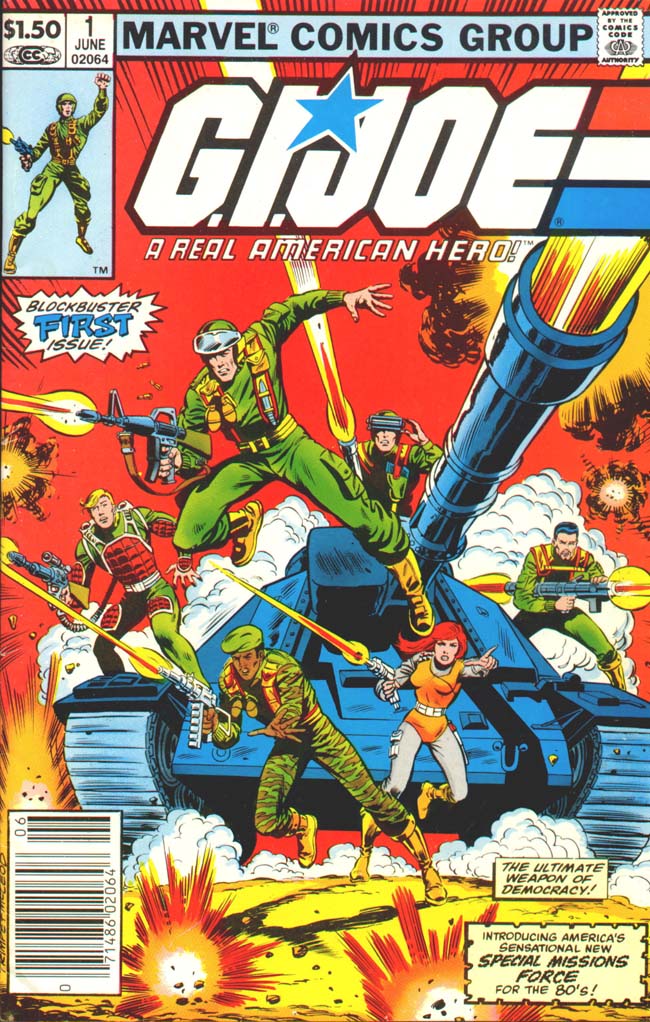
This is issue #1 of GI Joe, released in June 1982. It’s a big issue, with lots to talk about. Let’s get started!
What’s the story?
A prominent scientist—and controversial whistleblower who is publicly condemning a sketchy U.S. government weapons program—is kidnapped by Cobra, a stateless terrorist military force. GI Joe, the “sensational new special missions force for the ’80s,” is dispatched to raid the island fortress where Cobra is holding their prisoner. This setup turns out to be a Cobra trap (the first of many to come over the decades) intended to bait GI Joe into the open where they can be destroyed. Working in several small teams, a team of about a dozen Joes infiltrates the island, evades the trap, and rescues the scientist—although they fail to capture (not for the last time) a fleeing Cobra Commander and his sidekick, the Baroness.
What’s noteworthy about this issue?
The “real military” feel. Whereas some later incarnations of the GI Joe franchise veered into superspy or even near-superhero territory, with colorfully-costumed characters and sci-fi vehicles and weaponry, the GI Joe of 1982 is a fairly grounded affair. GI Joe is presented as a sort of elite extension of the regular military; they wear (mostly) regular-looking army fatigues; they have ranks, roles, tactics, and weapons that evoke the real military. Larry Hama, the revered Marvel talent who wrote and developed the GI Joe line for many years, was a Vietnam vet, and he brings a very noticeable “grunt’s eye view” to the franchise that will persist even as the stories, characters, and technology get more outlandish in later years.
That is not to say that this is a realistic story. The plots, villains, and action sequences are fanciful comic-book affairs with a light coating of real-world military terms and concepts sprinkled on top. Everyone here is a one-man army with access to sci-fi gadgets, but they act like grunts—grumbling about food in the mess hall, commiserating about boneheaded orders, etc.—and it gives this story and series a vibe that sets it apart from superhero stories.
Cobra is a nasty piece of work. In the later television cartoon, Cobra and its leadership are depicted as buffoonish clowns. Here, they’re a ruthless terrorist group with apparently a standing army (I recall that questions like “How is Cobra funding all these troops and gadgets?” are addressed to some extent in the series’ future). Their motives are left vague, but one gets the impression they’re mostly in this for the money, and that they plan to financially profit off of the info they can extract from their scientist prisoner.
Two named Cobra enemies appear in this issue—Baroness (who carries out the kidnapping with the help of her disguise/infiltration skills) and Cobra Commander, wearing a blue hood that evokes the KKK. Both are portrayed as ruthless jerks and murderers. Cobra Commander actually comes across as reasonably smart—he’s anticipated the government response to the kidnapping and accurately guesses how the Joes will go about their attack.
Cobra soldiers are masked, making them look like faceless hordes in contrast to GI Joe, whose members don’t (in most cases) hide their faces. I’m sure there’s plenty of psychological messaging to be unpacked there. Cobra’s vehicles and equipment resemble Soviet designs from the 70s and 80s. If the rows of goose-stepping, nameless soldiers didn’t do it, the MiG-like aircraft would definitely have evoked “enemy of freedom” vibes in the imaginations of 1980s readers. Soon, Cobra will get their own quirky and weird vehicles to match those in the GI Joe arsenal; I’ll be interested to see how long this Soviet aesthetic lingers. Certainly it’s an easy visual shortcut to let American readers in 1982 instantly recognize the bad guys:
The bullets are real! People can get killed in this comic! The guns are shooting real bullets! This is not a grim and gritty story of violence and its consequences, but it does feel important that already in issue #1, the Joes and Cobras alike are shooting to kill. Cobra appears to kill several bystanders during their kidnapping, and later executes the entire population of a village to prevent them from lending aid to the Joes (we see bodies strewn about in one mildly chilling panel).
That said, battle scenes are pretty tame—there’s no gore or realistic depictions of violence on display. And in one amusing scene, it’s suggested that the Joes, at least, are pulling their punches just a tad.
But this isn’t a cartoon world of blue and red lasers that never hit anything, where aircraft crew always manage to bail out when their plane is shot down.
In later years, keeping up with trends in the comic world, GI Joe will move in a grittier and more violent direction. For now, everything is overall quite tame, but the presence of real bullets establishes some stakes.
The politics are muddled and weird. The setup here is that a scientist has been tricked by the US government into working on technology for a project she finds morally abhorrent—a “doomsday machine”:
That seems pretty morally straightforward, right? A device that would incinerate the world’s population in response to a nuclear first strike is a bad thing, I think most people would agree. (The Soviets reportedly implemented just such a system in 1985, a few years after this comic hit the stands.) So the kidnapped whistleblower scientist is the hero of the story, right?
Well, not according to this comic. Upon hearing the news of her kidnapping, here are the responses suggested by the heroic members of America’s elite freedom force:
First, General Flagg suggests intentionally bungling a rescue operation to goad Cobra into executing their prisoner.
Other Joes chime in:
- Stalker sneers at the idea of rescuing “a woman who’s practically a traitor.”
- Snake-Eyes suggests carpet-bombing the entire island where she’s being held with B-52s to kill everyone there (including the civilian population). Scarlett later has to remind Snake-Eyes that killing the kidnapped scientist “with one well-placed shot” isn’t the plan.
- Short-Fuse describes the scientist as a “traitor.”
Yo, Joe!!!
To be fair, I think this issue is trying to find a middle ground here. In 1982, when this issue was published, the reputation of the US military and its government leaders was likely pretty low after the Vietnam War and the Watergate scandals. (And at the time of this issue’s publication, the US president was engaged in a startingly illegal and immoral arms sales scheme to circumvent Congressional disapproval, although Hama wouldn’t have known about that yet.) It’s impossible not to wonder if Larry Hama, drawing on his experiences as a veteran, is trying to remind us that the real-world US military is comprised of good and moral people—people who would risk their lives to save the life even of somebody who criticized the military.
In the end, the kidnapped scientist expresses remorse that she assumed she had a “monopoly on scruples.” I appreciate that she doesn’t back down from her views:
But there’s no reciprocation from the other side; no Joes acknowledge that the scientist is just as much a patriot as they are. I think that “We’ll come to your aid, even if you’ve criticized an ethically dubious military project!” is not the most inspiring slogan for America’s elite freedom force.
Ultimately, I think Hama is trying to deliver a nuanced message here, about the presence of fundamentally good people on different sides of a societal debate about America’s military operations and the people carrying them out. And in future issues, I think we’ll see him tease out this nuance more effectively. Here, it’s clunky and somewhat off-putting.
Favorite panel: I like this image of Cobra Commander parading around on a horse like a tin-pot dictator. It tells us that Cobra is a weird organization. Is it a would-be nation-state? A terrorist force motivated by ideology? A cult of personality? We’ll find out in future issues!
Next up: The Joes travel to the Middle East in “Hot Potato.”
